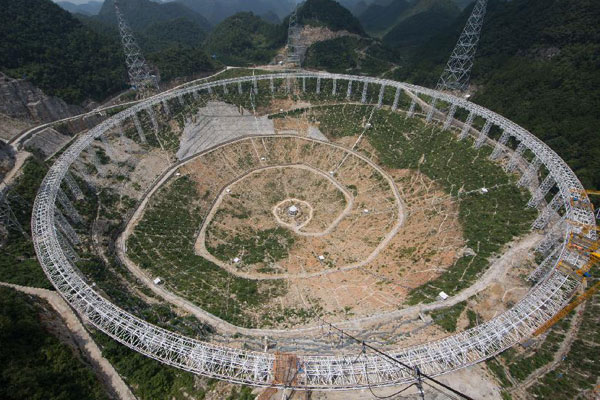China's equipment gains larger market in Brazil
Updated: 2015-08-03 04:00
By Yang Ziman(China Daily Latin America)
|
||||||||
The success of State Grid Corporation of China (SGCC), the country’s biggest power distributor, in winning the bid in July to build and operate the second power transmission line to connect Brazil’s Belo Monte hydropower plant to the national Brazilian grid will help China’s electrical equipment gain a bigger market overseas, said experts.
The power line stretches 2,500 kilometers from the hydroelectric complex in northern Para state in the Amazon jungle to southeastern Rio de Janeiro. SGCC operates the transmission line for 988 million reais ($309 million) a year under a 30-year concession to operate the power line.
The 11.2-gigawatt Belo Monte project on the Xingu River in the Amazon Basin is expected to begin operation by the end of the year. It will be the third biggest hydroelectric dam in the world after China’s Three Gorges dam and the Itaipu hydropower plant, also in Brazil.
According to a report on energy by Huatai Securities, SGCC has been expanding its overseas market with great effort. In the recent two years, SGCC has won a number of bids in South America, Africa, and Europe. Now its overseas assets in the Philippines, Brazil and Portugal are very stable. In the process, it actually helps Chinese electrical equipment manufacturers to tap into the overseas market.
SGCC already won the concession for the first power line of Belo Monte hydropower plant in 2013. It was the first time that SGCC had won the bid of an ultra-high voltage (UHV) project overseas.
“(Winning the of Belo Monte bid) means that China’s UHV technologies have been recognized overseas, which shows great potential in high-end electrical equipment manufacturing industry in the overseas market,” said the press release on SGCC’s website.
China now has world-leading UHV technologies, according to SGCC’s press release. The technology helps to carry large capacity of power in long distance with low loss and minimal take-up of land.
Since 2004, electricity consumption in China has been growing at an unprecedented rate due to the rapid growth of industrial sectors. Since then, China has very aggressively invested in electricity supply in order to fulfill the demand from industries and hence secure economic growth.
During the International Conference on UHV Power Transmission held in Beijing in 2009, SGCC announced an investment plan of 600 billion yuan into UHV development between then and 2020.
“The Belo Monte project will generate at least 3 billion yuan’s investment in equipment manufacturing in China,” Han Xiaoping, chief energy expert of china5e.com, an energy information and consulting service provider, said on China National Radio.
“It will also bring job opportunities for about 16,000 people in Brazil. The rainfall in the north of Brazil is bountiful, which is ideal for building hydropower plants. However, the main population lives down in the south. It’s similar case in China where energy resources are far away from the load centers. UHV is developed exactly to resolve the problem,” Han added.
“High speed train, nuclear power and UHV represent the most advanced equipment technologies in China. Plus, we have independent intellectual property rights over these technologies. Such kind of advantage in UHV is incomparable in the global market because not many large countries have the demand for long distance power transmission as in China. As a result, a lot of standards in UHV have been set by China,” said Han.
“China’s domestic electrical equipment manufacturers have acquired international standard technologies and experiences. Our products are of low cost and therefore have high performance-cost ratio, which has given us a distinctive advantage in the competition with expensive overseas competitors,” said Song Zhichen, researcher of energy of Shenzhen-based China Investment Consulting Net.
SGCC entered Brazil in 2010, when it acquired seven national power transmission companies, whose business cover the most developed southeastern parts of Brazil with high power demand. It now possesses $29.8 billion worth in overseas assets, operating major grids in Brazil, Portugal, Australia, Italy, the Philippines and Hong Kong.
- Remains of Chinese guard killed in Somalia attack return home
- Gala promotes gender equality
- Trafficked woman appeals to be left alone, continue her life
- Wreckage discovery shouldn't disrupt search: MH370 families
- 3,000 students attend pre-exam session in huge hall
- 38.7b yuan in State assets recovered in campaign

 Remains of Chinese guard killed in Somalia attack return home
Remains of Chinese guard killed in Somalia attack return home
 Top 10 international destinations for Chinese millionaires
Top 10 international destinations for Chinese millionaires
 Rainstorm affects 940,000 in South China
Rainstorm affects 940,000 in South China
 Do you take all your paid leave?
Do you take all your paid leave?
 National Art Museum of China displays Polish folk art
National Art Museum of China displays Polish folk art
 Chinese soldiers in parades
Chinese soldiers in parades
 US Marines Corpos soldiers demonstrate martial arts
US Marines Corpos soldiers demonstrate martial arts
 World's largest radio telescope being built
World's largest radio telescope being built
Most Viewed
Editor's Picks

|

|

|

|

|

|
Today's Top News
Remains of Chinese guard killed in Somalia attack return home
Professor accused of spying out on bond
Chinese defense concerned about US moves in South China Sea
Chinese named in test-taking scam deported from US
Baidu to buy back shares worth $1b
Former military leader Guo Boxiong expelled from CPC, to face justice
Pair to face poaching charges related to death of popular lion
Amazon wants air space for delivery drones
US Weekly

|

|






